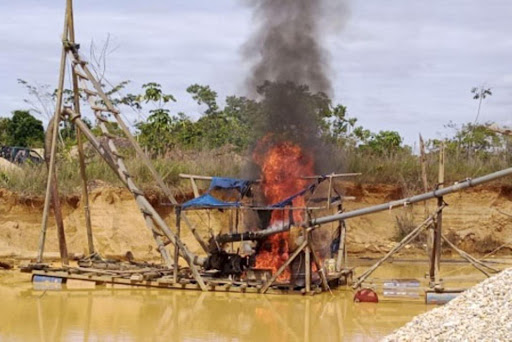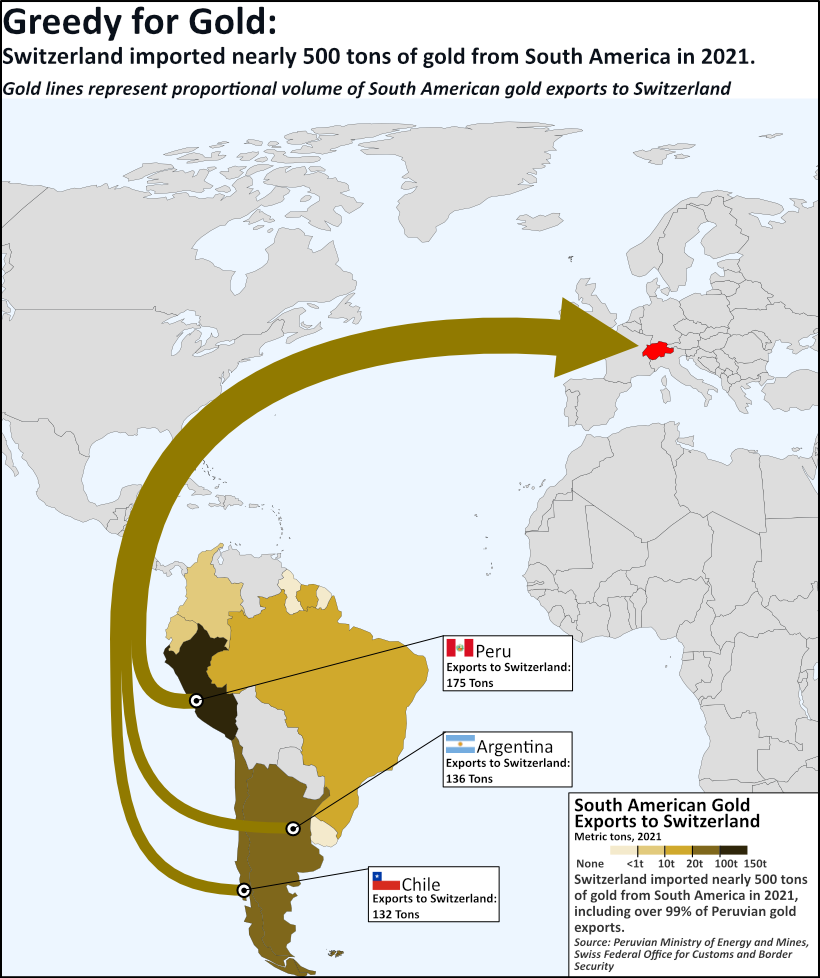
By Kelsey Lescop, Nicolas Berlinger, Sara Istefan and Sandra Daniel for Politico
One myth has captivated the imaginations of adventurers and miners since Europeans arrived in the Americas: El Dorado, a city of gold hidden in the Amazon jungle, promising riches to any who could find it.
For some, El Dorado was real: a city of gold clinging to the edge of the Amazon. But this town, La Pampa, was no fairytale. It was an illegal mining hub in the Madre de Dios region of Peru, riddled with organized crime, trafficking in both gold and humans, and polluted with toxic mercury.
There is another place renowned for its mountains, its gold, and its secrecy: the small nation of Switzerland is home to five of the world’s largest gold refineries. Estimates from its largest refiner, PAMP SA, indicate that about 70% of the world’s gold will pass through Switzerland each year. According to Peruvian government statistics, Switzerland imports at least a quarter of Peru’s annual gold production, and possibly much more. One major refiner in particular, Metalor Technologies, has repeatedly found itself caught up in controversy and scandal due to its close relationship with Peru’s illegal gold trade.
Metalor and Switzerland’s other major refineries provide a pathway to monetization for Peru’s illegal gold. That route is facilitated by intermediaries who bridge the gap between their Swiss customers and the illegal gold pits of the Amazon. The markets created by the Swiss fund criminal organisations which chronically violate Peru’s laws while destroying the country’s unique environment. .
OPERATION MERCURIO
La Pampa is in ruins. In 2019, the Peruvian government launched “Operation Mercurio”, a joint mission between the military and law enforcement which saw more than 1,200 police officers, 300 soldiers, and 70 specialized attorneys flood Madre de Dios, dismantling the city of La Pampa, expelling some 6,000 miners, liberating more than 50 people from human trafficking networks, and installing three military bases in the region.
Satellite analysis from the NGO Amazon Conservancy confirms that deforestation from illegal mining in Mercurio’s operational area decreased by up to 92% after the operation. However, some observers are concerned about its broader impact: Yvette Sierra, investigative journalist for the conservation news site Mongabay, points out that miners have shifted geography and tactics, “Miners are now plying the rivers with boats called Pequedragas”. These boats dredge the river beds for gold, and according to Yvette, many of the miners using these new techniques were displaced from La Pampa during Operation Mercurio, having simply shifted to other areas.
GREEN FORESTS, BLACK MARKETS
Peru’s Ministry of Energy and Mines (MINEM) reports that 90% of mining operations in Madre de Dios fall into the “artisanal” or “small producer” category. Artisanal operations are often run by individuals in precarious financial and legal circumstances. For example, In a recent speech, the region’s governor Jefferson Gonzales Enoki claimed that less than 0.1% of artisanal miners in Madre de Dios are officially registered. MINEM’s own statistics count only 300 companies and 1,181 mining workers registered in Madre de Dios. Meanwhile, reports from organizations such as USAID and Peru’s Ministry for the Environment estimate the number of illegal miners to be between 46,000 and 70,000.
National statistics on production and export are also inconsistent. Both MINEM and Peru’s National Institute for Statistics and Information report about 97 tons of gold production in 2021, but both agencies report 175 metric tons of gold exports in that same year. Based on MINEM’s figures, Switzerland should have received about 42 tons of gold in 2021, 24% of Peru’s exports. However, the Swiss Federal Office for Customs and Border Security records imports of 174 tons of gold from Peru in 2021. It is possible that the gap between these official records represents the flows of illegally-produced gold which are exiting the country through official export channels.
One such channel for the exportation of illegal gold to Switzerland was the gold trading company Minersur. In 2019, prosecutors in Peru investigated Minersur for its role in “an extensive network of front companies in Lima, Puno, and Madre de Dios”. This network was used “to support non-existent gold purchase and sale operations” in order to “camouflage commercial transactions for ore extracted from illegal sites,” according to documents obtained by the Peruvian investigative journalism publisher OjoPúblico.
The documents accused Metalor of acting as a “a financier for the sale of gold ore of illegal origin,” The reports accuse Metalor of “encouraging supplier’s illicit conduct” and purchasing over 100 tons of illegal gold valued at $3.5 billion from 2001 to 2018.
The prosecutors even name Metlor’s former CEO Philippe Royer and current General Counsel José Ramón Camino de Miguel as principal offenders in the case.
The reports describe Minersur as Metalor’s largest trading partner in Peru, but they also note Metalor’s connection to several other cases where suspected illegal gold was seized from intermediaries trading in Madre de Dios.
Intermediaries like Minersur play a key role in laundering and exporting illegal gold ore from the Amazon to Switzerland. According to a report by InsightCrime, a non-profit investigative journalism group, Traders and processing plants will purchase raw gold from several sources, but before the gold can be refined, it must have a receipt certifying its legal origin. Fake receipts are purchased from facturadores, or billers, and once illegal gold has been mixed with legal, it is nearly impossible to trace. According to Yvette Sierra, “The official documentation is simply used to sell the gold to acopiadores (gold traders) and later it goes to bigger bundlers who buy the gold in order to sell it for export.” She also highlighted that the existing documentation process is entirely paper-based, which facilitates document forging while hampering efforts to investigate suspicious gold.
A GOVERNMENT IN CRISIS
In June 2022, the Peruvian president Pedro Castillo met with an industry group representing artisanal miners in an effort to improve coordination with MINEM and reform national legislation in favor of an improved formalization process.
This hopeful moment for the industry did not last. In the six months since that meeting, Castillo has been ousted as president and imprisoned after a failed self-coup attempt. Forty-nine people have been killed in protests that erupted across the country after Mr. Castillo’s arrest. Many Peruvians are frustrated after almost twenty years of economic growth has brought great wealth to some while leaving many rural, working class, and indigenous Peruvians mired in poverty. Artisanal miners in Madre de Dios have been involved in protests and violent confrontations since August of 2022.Efforts at formalisation have failed in part because of the irresistible incentives to mine on lands beyond legal concessions. The Peruvian authorities created a mining corridor in Madre de Dios, where miners can apply for concessions, but as shown in the map below, mining operations have extended well beyond the established corridor, into border natural and indigenous reserves.

MERCURY RISING
In 2016, Peru ratified the Minamata Convention, regulating the usage of mercury. However, mercury still finds its way into the hands of miners who use it as a cheap and available tool to extract gold from ore.
Mercury is a potent neurotoxin, causing a range of physical and cognitive disabilities including ataxia, paralysis, organ failure, and the loss of speech, hearing, sight, and memory. At its most severe, it leads to Minamata Disease, a permanent degeneration of the nervous system that often leads to death. Mercury’s neurotoxicity also impacts plants and animals which are exposed to the chemical.
Mercury levels in the rivers, soil and even the canopies of the rainforests for hundreds of miles around mining sites are well past government safety limits. Research conducted by Duke University and the UK’s Royal Society of Chemistry has demonstrated that mercury from mining sites can end up hundreds of kilometers downstream from their origin point, ending up in fish which are consumed by local communities that rely on the rivers for their protein intake.
The poisoning of Madre de Dios is occurring in one of the world’s richest biodiversity hotspots, a place where over 545 species of birds can be found in a single 5.5km area, a world record according to the Amazon Rainforest Conservancy. Madre de Dios also has the world record for mercury throughfall according to the Duke University study. This type of pollution occurs when mercury in the air accumulates on the leaves of trees and falls to the ground during periods of rain.
But before the mercury accumulates on the trees in the forest, it is burned off, oftentimes in the middle of towns, blocks away from residences, community centers and schools. In Europe, industrial zones will typically have air mercury concentrations from 0.5 to 20 ng/m3. A study by researchers at Mercer University on air mercury pollution in Madre de Dios found concentrations of 2000 ng/m3 at a school in Laberinto. The source was determined to be a gold shop several blocks away which had closed the year before. The same study found concentrations of 2,000,000 ng/m3 on the sidewalks outside of the gold shops where mercury is burned.
There are projects targeting this problem, such as the Max-Havelaar-Foundation, which issues a Fair-Trade Certificate for Peruvian gold sold in Switzerland. The foundation educates miners on the responsible use and recycling of mercury and the mine’s supply chains. However, the usage of mercury is still used in the mines they are certifying and buying their gold from.
Markus Staub, Senior Project Manager Gold for Max-Havelaar-Foundation, argues that the use of mercury is the only economically viable solution for now, as alternatives require unaffordable investments from artisanal miners.
THE SWISS CONNECTION
On the heels of the 2018 revelations related to Minersur and several other scandals including the seizure of 91 kilograms of gold destined for its Swiss refinery, Metalor exited the Peruvian gold market entirely while at the same time discontinuing its trading relationships with all small and medium sized gold producers in South America.
Metalor is still able to access illegal gold from Madre de Dios. Peruvian officials have noted that since 2011, there has been a dramatic increase in transshipments of gold out of landlocked Bolivia through Peru. The Madre de Dios region shares a porous border with Bolivia, allowing traders to smuggle the gold to Bolivia, where it laundered and where companies like Metalor continue to operate.

Metalor is one player in an industry which is frequently criticized by NGOs such as The Society for Threatened People, which accuses the industry of being “repeatedly and at various levels in conflict with human rights, environmental protection and transparency”
Efforts to improve the industry’s sourcing are small and have close connections to industry leaders accused of wrongdoing. The Swiss Better Gold initiative is one of the larger projects intended to reduce the environmental impact of gold by training miners in best practices and offering small premiums for gold produced according to these practices. 2020 was its most productive year, helping to produce 3 tons of responsibly sourced gold. This accounts for about .61% of all gold imported into Switzerland from Latin America. On its board of directors is José Ramón Camino de Miguel, Metalor’s general counsel and one of the figures accused by name in the Peruvian investigation into Metalor’s purchases of over 100 tons of illegal gold.
Efforts to reform the country’s regulatory framework have also failed. The Responsible Business Initiative, a 2020 referendum aimed at penalizing Swiss companies complicit in human rights violations abroad, was narrowly rejected despite receiving a majority of the popular vote. The campaign was marked by controversial political tactics such as defamatory videos targeting the supporters of the campaign. According to Swiss newspaper Tages Anzeiger, these tactics were“new in their style and aggressiveness for a Swiss referendum campaign”
For Switzerland, a country that prides itself on its environmental beauty, ancient democratic traditions and adherence to the rule of law, its embrace of illegal gold threatens to undermine the social and environmental fabric of Peru.
